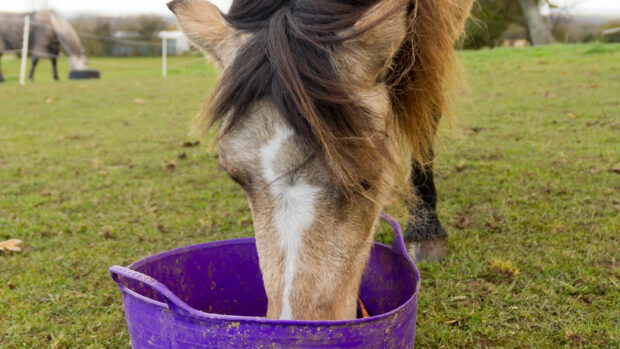Licks and supplement buckets both have a dual role — as a means of the supply of nutrients and also as a kind of “boredom reliever” for horses and ponies stabled or out at grass.
Generally, buckets and tubs weigh 10-12kg and are designed for the horse receiving little or no hard feed, either because of plentiful grass or because the animal is on box-rest. Generally, they are vitamin and mineral supplements, though one or two offer additional specific functional benefits, for instance in respiratory support. Typical guides to the recommended intakes vary from 100-250g per day.
The name “lick” is synonymous with salt licks, offered for horses to free-range their salt intakes. It is more common now to add salt directly to the diet, but licks are not yet completely out of fashion. Other licks sold as boredom breakers have little nutritional value, but plenty of “play” benefit.
Additional salt is required in horses’ diets for two reasons: first, supplies of this important electrolyte and nutrient may be limited in forage and hard feed, and second, salt is the one nutrient for which animals have a true appetite. While salt contents of compound feeds are not meagre (around 7-15g per kilo), higher levels cannot be added because salt is hydrophilic (attracts water).
For all mineral and vitamin tubs, licks and salt blocks, as long as the horse or pony eats the recommended amount per day, then the essential nutrients contained in them, especially trace elements for grass-kept animals, are supplied well.
However, those horses or ponies who do not consume the recommended amounts because they don’t like the taste, don’t consume enough or are bullied away, will not receive as much as they need. Such susceptible animals might be best with their own individual meal.
Check intakes either by watching the group use the buckets to spot who is missing out or by reconciling the rate of use with the on-pack feed guide — for instance when the tasty spring grass comes through, intakes from feed buckets may drop.
H&H top tips
- Using a lick or bucket is no reason for you not to check your horse at grass each day
- Secure stable-based licks well or leave in the manger. One block lasts from one to three months, so blocks used in the stable will get dirty and dusty
- If greedy horses munch their way through licks, this could present a health risk through choke or colic. For these horses, it’s best to provide nutrition through the feed bucket and use non-edible entertainment devices
|
||
 |
||


 Get up to 19 issues FREE
Get up to 19 issues FREE TO SUBSCRIBE
TO SUBSCRIBE 


